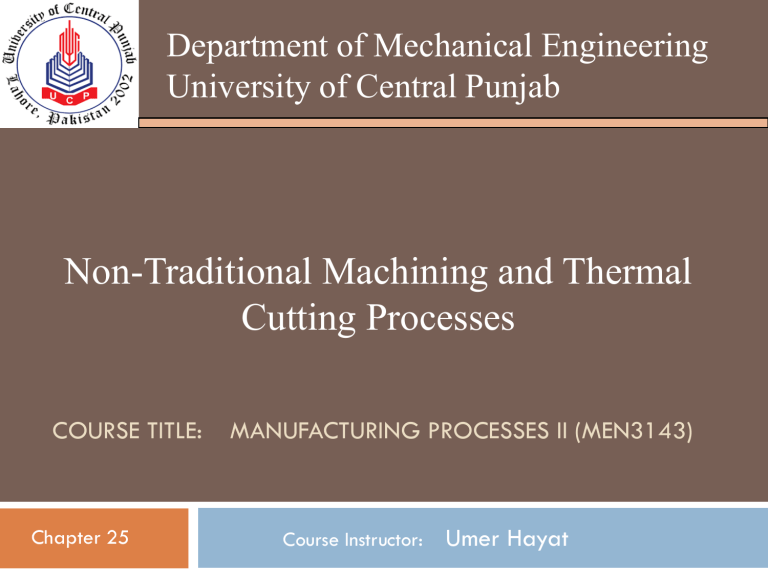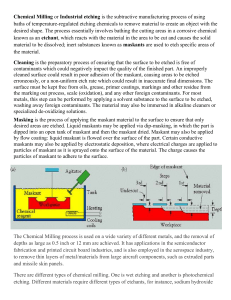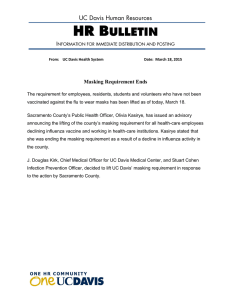
Department of Mechanical Engineering University of Central Punjab Non-Traditional Machining and Thermal Cutting Processes COURSE TITLE: Chapter 25 MANUFACTURING PROCESSES II (MEN3143) Course Instructor: Umer Hayat Summary of Last Lecture 2 Chemical Machining 3 Material removal through contact with a strong chemical etchant Processes include: Chemical milling Chemical blanking Chemical engraving Photochemical machining All utilize the same mechanism of material removal Steps in Chemical Machining 4 1. 2. 3. 4. Cleaning - to insure uniform etching Masking - a maskant (resist, chemically resistant to etchant) is applied to portions of work surface not to be etched Etching - part is immersed in etchant which chemically attacks those portions of work surface that are not masked Demasking - maskant is removed Chemical Milling 5 Figure 26.17 - Sequence of processing steps in chemical milling: (1) clean raw part, (2) apply maskant, (3) scribe, cut, and peel the maskant from areas to be etched, (4) etch, and (5) remove maskant and clean to yield finished part Maskant in Chemical Machining 6 Materials: neoprene, polyvinylchloride, polyethylene, and other polymers Masking accomplished by any of three methods: Cut and peel Photographic resist Screen resist Masking – Cut and Peel Maskant Method Maskant is applied over entire part by dipping, painting, or spraying After maskant hardens, it is cut by hand using a scribing knife and peeled away in areas of work surface to be etched Used for large workparts, low production quantities, and where accuracy is not a critical factor Masking – Photographic Resist Method 7 Masking materials contain photosensitive chemicals Maskant is applied to work surface and exposed to light through a negative image of areas to be etched These areas are then removed using photographic developing techniques Remaining areas are vulnerable to etching Applications: Small parts are produced in high quantities Used where close tolerances are requied Fabrication of integrated circuits and printed circuit cards Masking – Screen Resist Method 8 Maskant applied by “silk screening” methods Maskant is painted through a silk or stainless steel mesh containing stencil onto surface areas that are not to be etched Applications: Between other two masking methods Fabrication of printed circuit boards Not as precise as photoresist method Etchant 9 Factors in selection of etchant: Work material Depth and rate of material removal Surface finish requirements Etchant must also be matched with the type of maskant to insure that maskant material is not chemically attacked Material Removal Rate in CHM 10 Generally indicated as penetration rates, mm/min (in/min), since rate of chemical attack is directed into surface Penetration rate is unaffected by surface area Typical penetration between 0.020 and 0.050 mm/min (0.0008 and 0.002 in./min) Undercut in CHM Etching occurs downward and sideways under the maskant Applications of Chemical Milling 11 Largely used in aircraft industrty Remove material from aircraft wing and fuselage panels for weight reduction Applicable to large parts where substantial amounts of metal are removed Cut and peel maskant method is used Chemical Blanking 12 Uses chemical erosion to cut very thin sheetmetal parts - down to 0.025 mm (0.001 in) thick and/or for intricate cutting patterns Conventional punch and die does not work because stamping forces damage the thin sheetmetal, or tooling cost is prohibitive, or both Maskant methods are either photoresist or screen resist Tolerances as close as 0.0025 mm can be held on 0.025mm thick stock using the photoresist method Applications of Chemical Blanking 13 Application of chemical blanking is generally limited to thin materials and/or intricate patterns Maximum stock thickness is around 0.75 mm (0.030 in) Hardened and brittle materials can be processed by chemical blanking where mechanical methods would surely fracture the work Chemical Engraving 14 Chemical machining process for making name plates and other flat panels that have lettering and/or artwork on one side These plates and panels would otherwise be made using a conventional engraving machine Masking is done by either the photoresist or screen resist methods Photochemical Machining (PCM) 15 Uses photoresist masking method Applies to chemical blanking and chemical engraving when photographic resist method is used Used extensively in the electronics industry to produce intricate circuit designs on semiconductor wafers Also used in printed circuit board fabrication Application Considerations 16 Work Materials 17 As a group the nontraditional processes can be applied to metals and non-metals However, certain processes are not suited to certain work materials Several processes can be used on metals but not nonmetals: ECM EDM PAM and wire EDM Performance of Nontraditional Processes 18 The nontraditional processes are generally characterized by low material removal rates and high specific energies relative to conventional machining operations. The capabilities for dimensional control and surface finish of the nontraditional processes vary widely, with some of the processes providing high accuracies and good finishes, and others yielding poor accuracies and finishes. Surface damage is also a consideration. Some of these processes produce very little metallurgical damage at and immediately below the work surface, whereas others (mostly the thermal-based processes) do considerable damage to the surface. Nontraditional processes are generally used where conventional methods are not practical or economical.



